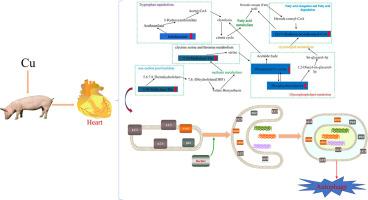Ecotoxicology and Environmental Safety ( IF 6.8 ) Pub Date : 2021-02-18 , DOI: 10.1016/j.ecoenv.2021.112040 Quanwei Li , Jianzhao Liao , Chaiqin Lei , Jian Shi , Hui Zhang , Qingyue Han , Jianying Guo , Lianmei Hu , Ying Li , Jiaqiang Pan , Zhaoxin Tang

|
Among different synthetic compounds copper (Cu) is persistently and frequently used as growth promoter, antibacterial, antifungal and antiparasitic agent and has become common environmental pollutant. Therefore, this study explores the cardio-toxic effects of control group (10 mg/kg bw Cu) and treatment group (125 and 250 mg/kg bw Cu), and it association with process of autophagy and metabolomics in myocardium of pigs kept in three different experimental treatments for a period of 80 days. The results of serum biochemical parameters showed a significantly increase in creatinine kinase (CK), creatine kinase-MB (CK-MB), high density lipoprotein-cholesterol (HDL-C), low density lipoprotein-cholesterol (LDL-C) and aspartate aminotransferase (AST) in pigs exposed to 125 mg/kg bw and 250 mg/kg bw Cu. Meanwhile, the severe structural abnormalities in cardiomyocytes were found when exposed to 250 mg/kg Cu at day 80. In addition, the mRNA and proteins (Beclin1, ATG5 and LC3II) expression levels were significantly increased and p62 was significantly decreased in cardiomyocytes exposed to 250 mg/kg Cu at day 80 of the trial. Further, UPLC-QTOF/MS technique showed that 7 metabolites were up-regulated and 37 metabolites were down-regulated in cardiomyocytes after 250 mg/kg Cu treatment, with a principal impact on the metabolic pathways including glycerophospholipid metabolism, one carbon pool by folate, fatty acid elongation and fatty acid degradation, which were related to autophagy. Overall, our study identified the autophagy processes and metabolites in metabolic pathways in Cu-induced myocardium injury, which provided useful evidence of myocardium toxicity caused by Cu exposure via metabolomics and multiple bioanalytic methods.
中文翻译:

代谢组学分析揭示了铜对猪心肌自噬的影响
在不同的合成化合物中,铜(Cu)一直被频繁地用作生长促进剂,抗菌,抗真菌和抗寄生虫剂,并已成为常见的环境污染物。因此,本研究探讨了对照组(10 mg / kg bw Cu)和治疗组(125和250 mg / kg bw Cu)的心脏毒性作用,并将其与饲养猪的心肌自噬和代谢组学过程相关联。三种不同的实验治疗方法,为期80天。血清生化参数的结果表明,肌酸酐激酶(CK),肌酸激酶-MB(CK-MB),高密度脂蛋白胆固醇(HDL-C),低密度脂蛋白胆固醇(LDL-C)和天冬氨酸显着增加暴露于125 mg / kg bw和250 mg / kg bw铜的猪中的氨基转移酶(AST)。同时,Beclin1,ATG5和LC3II的表达水平显着升高,p62在试验的第80天,暴露于250 mg / kg Cu的心肌细胞中的TNF-α明显降低。此外,UPLC-QTOF / MS技术显示,在250 mg / kg Cu处理后,心肌细胞中的7种代谢物被上调,而37种代谢物被下调,这对包括甘油磷脂代谢,叶酸的一个碳库在内的代谢途径产生主要影响。 ,脂肪酸伸长和脂肪酸降解,这与自噬有关。总体而言,我们的研究确定了铜诱导的心肌损伤中代谢途径的自噬过程和代谢物,这为通过代谢组学和多种生物分析方法暴露于铜引起的心肌毒性提供了有用的证据。



























 京公网安备 11010802027423号
京公网安备 11010802027423号